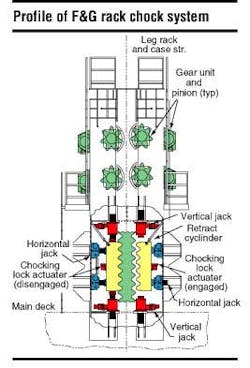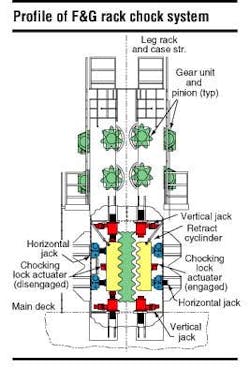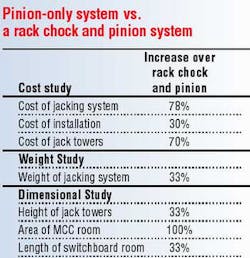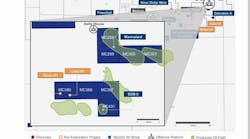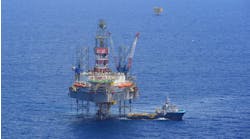Double enveloping gear improves advanced rack chock operating system
The Advanced Rack Chock Operating System (ARCOS), designed by Friede & Goldman Ltd. (F&G), is faster and more efficient than its predecessors. The most significant innovation in the mechanism of the ARCOS is the double enveloping gear. This design uses a concave face, which allows the horizontal worm gear more contact surfaces. The increased surface area aids in raising and lowering the screw jacks.
On the surface, the enhanced functionality of the gear seems like a simple improvement. F&G engineers took a commonly used gear and applied it, for the first time, to a rack chock system. The effects of this seemingly simple innovation are considerable for drillers. By providing more contact points, the gear generates higher torque, which translates into greater strength in the overall system.
Bigger rigs, more weight
As jackup rigs grew in size and capabilities, they gradually moved from marshlands into shallow water, and then into water depths greater than 200 ft. Greater water depths require improved drilling equipment. Deeper wells require more drilling tubulars and fluids on board. In short, the tools needed to go deeper create greater weight on the platform even before any drilling activity took place.
Once a jackup begins drilling a well, the added weight hanging off of the derrick further complicates the issue. Additional holding capacity is needed while the rig is elevated and drilling. The rig experiences greater hook loads when pulling drilling tubulars from the hole. Add to this the need to carry more supplies onboard, and the need for new and improved jackup designs becomes evident. All of these factors combine to create the need for bigger and technologically advanced rigs.
With modern jackup designs, additional leg-to-hull holding capacity is needed when the rig is undertow moving from one location to another. The height of the legs extended above the hull creates extreme stress on the hull during tow when subjected to rough seas. The combined forces acting on a jackup without a rack chock would require higher rated elevating pinions and stronger jack towers.
As jackup rigs move farther offshore, environmental loads begin to increase. Wave and current forces and high winds take a great toll on larger jackups and exert more strain on the jacking systems.
The need for a rack chock
Modern jackup rigs need a leg fixation system to stabilize the hull and increase the rig's ability to withstand high loads. While the same strength could be achieved by adding more elevating pinions, adding machinery to reach the same objectives increases the weight of the rig, which exacerbates the loading problem as it attempts to resolve the problem. Adding pinions is also costly, and attempting to solve the loading problem by adding pinions alone normally ends up being cost prohibitive.
Another engineering consideration when addressing the loading issue is the role of horizontal loads that come to bear on the rig. These cannot be taken out by pinions alone. By strengthening the horizontal and vertical screw jacks in the ARCOS, engineers have been able to pinpoint a single area that can be fortified to increase the capability of the entire rig. F&G engineers claim that the ARCOS provides 260% greater capability than using pinions alone.
Evolution
F&G secured its first patent on a rack chock system in the 1970s. The original rack chock systems were entirely manually operated. Roughnecks provided the manpower necessary to turn the large rack chock screw jacks. This process was very slow and required a high level of manpower.
In the last five years, F&G has made innovations to the design that resulted in two additional patents. The second generation of the F&G rack chock system had jacks that used a single tooth contact and pinion drive gear. Workers armed with a large air-driven wrench drove the pinion.
ARCOS, F&G's newest design, takes the process to the next level. The double enveloping gear generates more strength, and the new system eliminates manual intervention, which reduces not only the amount of work required to set the chock, but reduces safety risk to the crew as well. The remotely operated push-button control no longer requires a person to physically adjust the gear. And the ARCOS design also physically relocates the entire system to an elevation above the water line, making it more accessible from the main deck and eliminating the necessity for a person to enter the water to repair or maintain the system.
